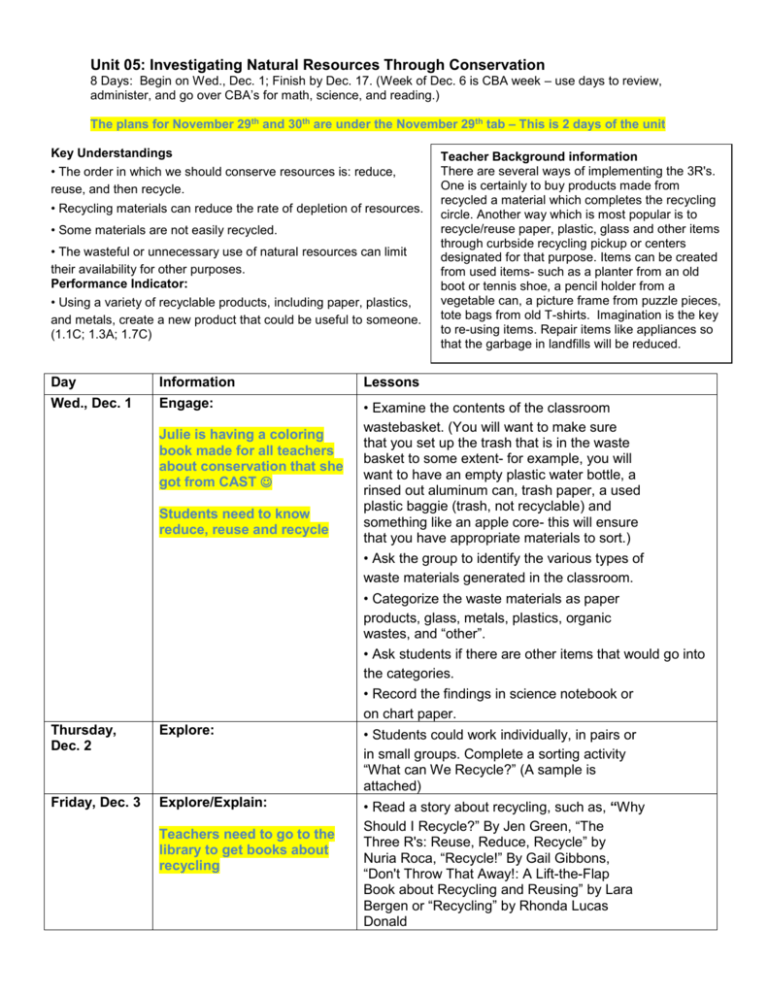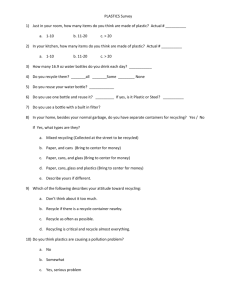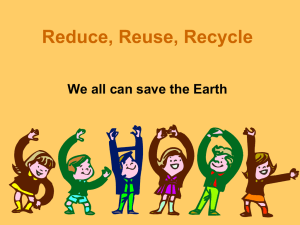SO_NOTED_GR_1_Science_Dec_1
advertisement

Unit 05: Investigating Natural Resources Through Conservation 8 Days: Begin on Wed., Dec. 1; Finish by Dec. 17. (Week of Dec. 6 is CBA week – use days to review, administer, and go over CBA’s for math, science, and reading.) The plans for November 29th and 30th are under the November 29th tab – This is 2 days of the unit Key Understandings • The order in which we should conserve resources is: reduce, reuse, and then recycle. • Recycling materials can reduce the rate of depletion of resources. • Some materials are not easily recycled. • The wasteful or unnecessary use of natural resources can limit their availability for other purposes. Performance Indicator: • Using a variety of recyclable products, including paper, plastics, and metals, create a new product that could be useful to someone. (1.1C; 1.3A; 1.7C) Teacher Background information There are several ways of implementing the 3R's. One is certainly to buy products made from recycled a material which completes the recycling circle. Another way which is most popular is to recycle/reuse paper, plastic, glass and other items through curbside recycling pickup or centers designated for that purpose. Items can be created from used items- such as a planter from an old boot or tennis shoe, a pencil holder from a vegetable can, a picture frame from puzzle pieces, tote bags from old T-shirts. Imagination is the key to re-using items. Repair items like appliances so that the garbage in landfills will be reduced. Day Information Lessons Wed., Dec. 1 Engage: • Examine the contents of the classroom wastebasket. (You will want to make sure that you set up the trash that is in the waste basket to some extent- for example, you will want to have an empty plastic water bottle, a rinsed out aluminum can, trash paper, a used plastic baggie (trash, not recyclable) and something like an apple core- this will ensure that you have appropriate materials to sort.) • Ask the group to identify the various types of waste materials generated in the classroom. • Categorize the waste materials as paper products, glass, metals, plastics, organic wastes, and “other”. • Ask students if there are other items that would go into the categories. • Record the findings in science notebook or on chart paper. Julie is having a coloring book made for all teachers about conservation that she got from CAST Students need to know reduce, reuse and recycle Thursday, Dec. 2 Explore: • Students could work individually, in pairs or in small groups. Complete a sorting activity “What can We Recycle?” (A sample is attached) Friday, Dec. 3 Explore/Explain: • Read a story about recycling, such as, “Why Should I Recycle?” By Jen Green, “The Three R's: Reuse, Reduce, Recycle” by Nuria Roca, “Recycle!” By Gail Gibbons, “Don't Throw That Away!: A Lift-the-Flap Book about Recycling and Reusing” by Lara Bergen or “Recycling” by Rhonda Lucas Donald Teachers need to go to the library to get books about recycling Week of Dec. 6 REVIEW for and GIVE CBA’s Monday, December 13 Explore/Explain: No new lessons this week. Teachers could do some review activities. Have students bring empty items from home – see list in next column • Display a selection of items, such as, but not limited to soup can (rinsed out), old boot, cereal boxes, clothing, milk cartons, milk jugs, egg cartons, puzzles that are missing pieces. • Choose one item and as a whole class brainstorm as many new ways to use the item as they can. • Have small groups repeat this activity with another item. Record ideas in science notebook. • Have a class discussion about why reducing, reusing and recycling is important for the environment. Make sure to include the following understandings as part of the conversation: � Recycling materials can reduce the rate of depletion of resources. � Some materials are not easily recycled. � The wasteful or unnecessary use of natural resources can limit their availability for other purposes. Tuesday, Dec 14 Elaborate: • Now that students have an idea about what kinds of materials can be recycled (glass, plastic, paper, aluminum cans), show some short video clips on how these products are made from resources that come from the Earth: • How glass is made: http://videos.howstuffworks.com/discovery/28024 -some-assembly-required-how-glass-is-madevideo. htm • How paper is made: http://www.forestryvideos.net/videos/international -paper-company-the-story-of-paper-1 • How aluminum cans are recycled http://www.flixya.com/video/1399391/How_Alumi num_Cans_are_made() • How plastic bottles are made http://www.dailymotion.com/video/xauw2o_recycl ing-plastic-water-bottles_tech Wed., Dec. 15 Evaluate: • Performance Indicator: Using a variety of recyclable products, including paper, plastics, and metals, create a new product that could be useful to someone. (1.1C; 1.3A; 1.7C) Thurs., Dec. TEACHER DAY; Early Release 17





